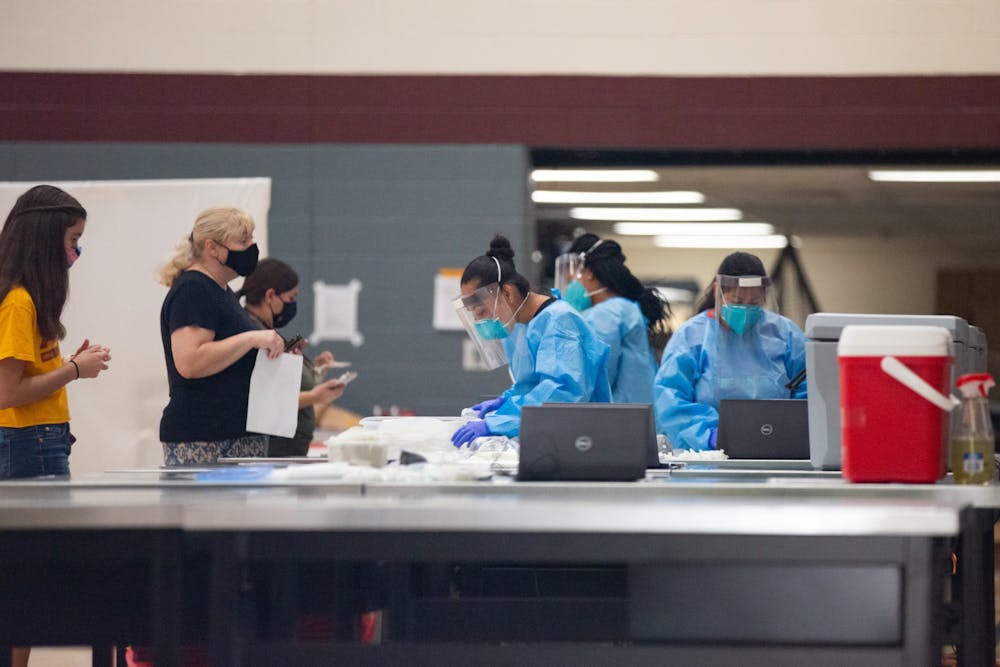On the same day ASU reported its largest increase in active COVID-19 cases in weeks — up 63 cases from Monday among students and employees — Arizona reported over 2,000 new positive cases of the coronavirus for the first time since Aug. 1, and the nation recorded more than 110,000 new cases.
According to an update Thursday night from the University, active cases among students now stand at 144, an increase of 53 infections since Monday's update. Employee active cases are now at 26, a 10-case increase. There are now 170 active cases within the ASU community.
There are 119 active cases among students off campus in the metropolitan Phoenix area, and 23 students are in isolation on the Tempe campus. The remaining two cases are on the Downtown Phoenix, West or Polytechnic campuses, a change from Monday's update when zero cases were reported across the three locations.
And while the University has tested approximately 110,001 students and employees since Aug. 1, it is not seeing as much random testing as it would like, said University officials guiding ASU's coronavirus response.
Interim Executive Vice President of ASU's Knowledge Enterprise Neal Woodbury said around 50% of on-campus students have been compliant with random testing, while around 25% of off-campus students are compliant. "But we need that (rate) higher," he said.
"Because the problem is that biases our (testing) outcomes," Woodbury said. He added, "our measurement would be better if we had 80% compliance."
Random testing is a key part of the University's decision-making process for this semester and the next. Will Humble, executive director for the Arizona Public Health Association, said if random testing "is a key element, you need to have enforcement."
The University had hoped a "Community of Care" would motivate students to be compliant, but they will likely have to use more enforcement and give students more flexibility on how soon they need to get tested to increase compliance, Woodbury said.
Woodbury encouraged more students to comply with testing because it "really helps us to monitor in a more accurate way what's really happening" with the spread of the coronavirus on campus. According to Monday's update, from Oct. 24-31 2,324 students were tested using the random testing program.
Since Aug. 1, cumulative cases among students and employees have risen by 125 to 2,303 in total. Students make up 2,230 and employees account for 73.
The key in noticing COVID-19 trends within a community, Humble said, is paying attention to denominators — numbers that can help create statistical values — and not just whole numbers.
There are a few to keep an eye on during the pandemic: case rates, the percent positivity rate, which represents the level of transmission of the virus and shows if the testing is effective, and the Rt number, which represents the average amount of people who become infected by another person, he said.
The ASU community's percent positivity rate is roughly 2%, using the cumulative number of positive results as the numerator and the total number of tests collected as the denominator. Arizona's Rt number is currently 1.11.
"Everyone pays attention to numerators," Humble said. "But numerators don't mean anything without denominators. And you have to have both for something to have context in epidemiology."
Those numbers to "pay attention to" are showing signs for concern. Data from the COVID Tracking Project shows new cases, hospitalizations and deaths are all on the rise in Arizona and across the country.
Across the U.S., "we are definitely in an exponential growth rate" of new cases, said Joshua LaBaer, executive director of ASU's Biodesign Institute at a press briefing Wednesday. That day, the U.S. recorded over 100,000 new cases, and trends showing similarly high numbers will be seen in the following days and weeks, LaBaer said.
"That is more than the total number of cases in the original Wuhan outbreak," he said. "We are seeing the same number of new cases per day in the U.S., as were found in the entire outbreak over the course of a month or two in Milan," during the Italian city's initial outbreak earlier this year.
On Thursday, the Arizona Department of Health Services reported 2,135 new COVID-19 cases. According to data from ASU's Biodesign Critical COVID-19 Trends website, 11 of 15 counties in the state are experiencing growth in their 7-day positive test rate.
Internal tracking of ADHS ZIP code data where ASU campuses are located — 85281, 85004, 85306 and 85212 along with the 85282 ZIP code in Tempe — done by The State Press shows cumulative cases have increased by 170 since Monday.
There were 112 combined new cases reported between Tempe's 85281 and 85282 ZIP codes since Monday. The 85212 ZIP code, where the Polytechnic campus is located, reported 42 new cases. The 85004 and 85306 ZIP codes combined reported 16 new cases since Monday.
In Maricopa County, where ASU's four main campuses are located, positive test rates have been at 12.77% over the last seven days.
Through the first five days of November, the state has seen over 11% of tests return positive – about 4% higher than what the state recommends for reopening schools.
"We're seeing too many new cases every day here in the state," LaBaer said. "Obviously, it's not rising quite as rapidly as it did at the end of June. "But it is rising consistently day over day.
"And that's a concern."
Senior reporter Piper Hansen contributed to this article.
Reach the reporter at wmyskow@asu.edu and follow @wmyskow on Twitter.
Like The State Press on Facebook and follow @statepress on Twitter.

Wyatt Myskow is the project manager at The State Press, where he oversees enterprise stories for the publication. He also works at The Arizona Republic, where he covers the cities of Peoria and Surprise.




